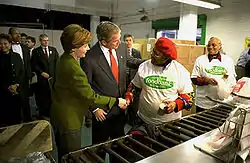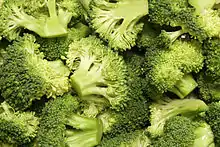Capital Area Food Bank
The Capital Area Food Bank is the largest organization in the Washington metro area working to solve hunger and its companion problems: chronic undernutrition, heart disease, diabetes, and obesity. By partnering with over 450 community organizations in the District of Columbia, Maryland, and Virginia, as well as delivering food directly into hard to reach areas, each year the Capital Area Food Bank is helping nearly half a million people each year get access to good, healthy food.
 | |
| Formation | October 24, 1979[1] |
|---|---|
| Type | 501(c)(3) nonprofit organization[2] |
| 52-11677581[2] | |
| Headquarters | Michigan Park, Washington, D.C. |
| Coordinates | |
Region | Washington metropolitan area |
| Services | Hunger relief, nutrition education, healthy food access |
Founder and former President | Lynn Brantley (1980–2012) |
Former President and CEO | Nancy Roman (2013–2017)[2] |
President and CEO | Radha Muthiah (2018– ) |
Board Chairman | Peter Schnall |
Parent organization | Feeding America |
| Subsidiaries | Capital Area Food Bank Foundation[2] |
Revenue (2014) | $53,559,173[2] |
| Expenses (2014) | $59,912,375[2] |
Staff (2013) | 153[2] |
Volunteers (2013) | 21,000[2] |
| Website | capitalareafoodbank |
In fiscal year 2015, the food bank provided nearly 45 million pounds of food—the equivalent of 36 million meals—to the region. In addition to food, the food bank also provides nutrition education and cooking classes,[3] empowering those it serves with the information and skills to shop for and cook healthy meals on a budget.
Counties served by Capital Area Food Bank[4] include District of Columbia DC, Montgomery MD, Prince George's MD, Arlington VA, Fairfax VA, Prince William VA, Alexandria (City) VA, Fairfax (City) VA, Falls Church (City) VA, Manassas (City) VA, and Manassas Park (City) VA.
The Capital Area Food Bank operates with the assistance of 21,000 volunteers annually,[2] who donate their time to help sort food, teach classes, and perform other important functions for the food bank.[5] The food bank is a member of Feeding America.
History

The Capital Area Food Bank was officially incorporated on October 24, 1979,[1] but it considers its founding date to be January 15, 1980 coinciding with Martin Luther King Jr.'s fifty-first birthday.[6] Prior to that time, the United States government's Food Stamp Program had been the city's primary source of assisting hungry residents.[7] However, cutbacks in the Food Stamp Program planned for the early 1980s led to the food bank's inception by two local organizations, the United Planning Organization and the Interfaith Conference of Metropolitan Washington.[6] In its first year of operation, the food bank managed to offer food to almost one hundred organizations and deliver 1,540 pounds (700 kilograms) of food each month.[5][6] Throughout the rest of the 1980s, the Capital Area Food Bank proceeded to prosper as it partnered with nearby corporations, such as The Washington Post.
In 1991, the Capital Area Food Bank opened a new warehouse in the Brookland neighborhood in northeast Washington, D.C.. The new 48,000-square-foot (4,500 m2)[6] warehouse is more than three times as large as the food bank's original 14,000-square-foot (1,300 m2) warehouse and continues to serve the Capital Area Food Bank today.
In 1998, the food bank opened another warehouse, in Lorton, Virginia, which has since served the needs of residents of Northern Virginia.[6]
In 2004, the first ever Blue Jeans Ball – then called the Farmer’s Blue Jeans Ball – was held at Catholic University.
In 1981, just over one million pounds (460,000 kilograms) were processed by the Capital Area Food Bank. Less than twenty-five years later, in 2005, the food bank outputs over 20 million pounds (9 million kilograms) of food to over 275,000 people, making it the largest food bank in the area.[6][8]
In 2007, the Capital Area Food Bank distributed 20 million pounds of food and served approximately 383,000 people in the Washington metro area.
In 2010, its 30th year, the food bank distributed 15 million pounds of fresh produce in one year for the first time.
In 2012, the Capital Area Food Bank moved to the Bedford Falls Foundation Distribution Center, allowing the organization to dramatically increase its distribution of good food and expand its education spaces.
In 2013, the 8,000-square foot Urban Demonstration Garden, a food growing and education space housed behind the food bank, finished its first season.
In 2014, the Capital Area Food Bank increased its reach to 540,300 people with 42 million pounds of food.[9] The newly launched Fruits and Vegetables Fund for Greater Washington, through which the food bank contract grows fresh produce with local farmers, concluded its first full growing season with support from the J. Willard and Alice S. Marriott Foundation.
In 2015, the Capital Area Food bank distributed 46 million pounds of food, 40% of which was fruits and vegetables.
In 2016, the food bank put a new food acceptance policy[10] in place that prioritizes foods lower in sugar and salt and higher in fiber. With help from its retailers, junk food donations dropped by 84% in one year.
In 2017, information about affordable cooking was made accessible for thousands more people when the food bank’s recipe cards – which show how to easily prepare a delicious, healthy meal for a family of 4 for $7 or less – were rolled out in all of the area’s 93 Giant stores.
Political importance


| External video | |
|---|---|
Due to its central location near the seat of the United States government, the Capital Area Food Bank has been a popular stop for politicians. Four consecutive U.S. presidents — George H.W. Bush, Bill Clinton, George W. Bush, and Barack Obama — have visited the food bank.
In 1990, sitting president George H.W. Bush banned broccoli from Air Force One,[11] stating, "I do not like broccoli. And I haven't liked it since I was a little kid and my mother made me eat it, and I'm President of the United States. And I’m not going to eat any more broccoli."[12] In response to the ban, an estimated ten tons of broccoli were sent to the White House, which Barbara Bush in turn donated to the Capital Area Food Bank.[13] That same year, the president visited the food bank and incorporated it into his Points of Light Foundation.[6]
On Inauguration Day, 1993, more than thirty-five thousand cans, including one from Tipper Gore, were collected for the Capital Area Food Bank.[6] In 1999, President Bill Clinton visited the food bank to volunteer and George W. Bush duplicated that act in 2002.[14] Likewise, less than two weeks before Super Bowl XXXVIII in 2004, U.S. First Lady Laura Bush visited the Capital Area Food Bank to encourage Americans to participate in charitable activities.[6][15] Other politicians have shown their support for the food bank by donating or otherwise promoting the cause of the Capital Area Food Bank. In 2005, for example, Maryland and Virginia Congressmen Chris Van Hollen, Steny Hoyer, Jim Moran, Frank Wolf, and Albert Wynn were successful in requesting US$1.3 million in federal funds for the food bank.[8]
See also
- America's Second Harvest – the nationwide food bank network that includes the Capital Area Food Bank
References
- "Capital Area Food Bank". Corporations Division. District of Columbia Department of Consumer and Regulatory Affairs. Retrieved October 21, 2015.
- "Form 990: Return of Organization Exempt from Income Tax" (PDF). Capital Area Food Bank Inc. Guidestar. December 22, 2014. Retrieved October 22, 2015.
- "Nutrition Education". Capital Area Food Bank – Washington, DC Metro Area. Retrieved 2018-03-30.
- "Capital Area Food Bank". Feeding America. Retrieved 2018-04-02.
- "Frequently Asked Questions". The Capital Area Food Bank. Archived from the original on May 1, 2006. Retrieved August 6, 2006.
- "Chronology" (PDF). Capital Area Food Bank. Archived from the original (PDF) on 2006-08-26. Retrieved 2006-08-05.
- "About Us: CAFB History". The Capital Area Food Bank. Archived from the original on 2006-05-01. Retrieved 2006-08-05.
- "Capital Area Food Bank to Receive Federal Funds". The U.S. House of Representatives. 2005-11-18. Archived from the original on 2006-07-31. Retrieved 2006-08-06.
- http://www.capitalareafoodbank.org/wp-content/uploads/2009/08/ar-2015.pdf
- Stein, Perry (2016-08-25). "Want to donate junk food? The region's largest food bank will reject it". Washington Post. ISSN 0190-8286. Retrieved 2018-04-13.
- Wizda, Sharyn (March 19, 1990). "Personalities". The Washington Post. p. C3.
- "What's Your Beef?". PBS. January 20, 1998. Archived from the original on October 7, 1999. Retrieved August 5, 2006.
- "A Bunch of Broccoli". The Washington Post. March 27, 1990. p. B3.
- "President Visits D.C. Food Bank". The White House. 2002-12-19. Retrieved 2006-08-06.
- "Mrs. Bush's Remarks at Capital Area Food Bank's Souper Bowl of Caring". The White House. 2004-01-22. Retrieved 2006-08-06.